StashAway is a robo advisory digital wealth management platform that personalizes financial planning and portfolio management for the vast range of needs of retail and accredited investors alike. StashAway’s proprietary investment strategy uses macroeconomic data to maintain each investors’ personal risk preferences through any economic environment. To achieve this, it leverages technology that determines asset allocations that simultaneously mitigate risk and maximize returns for any given portfolio.
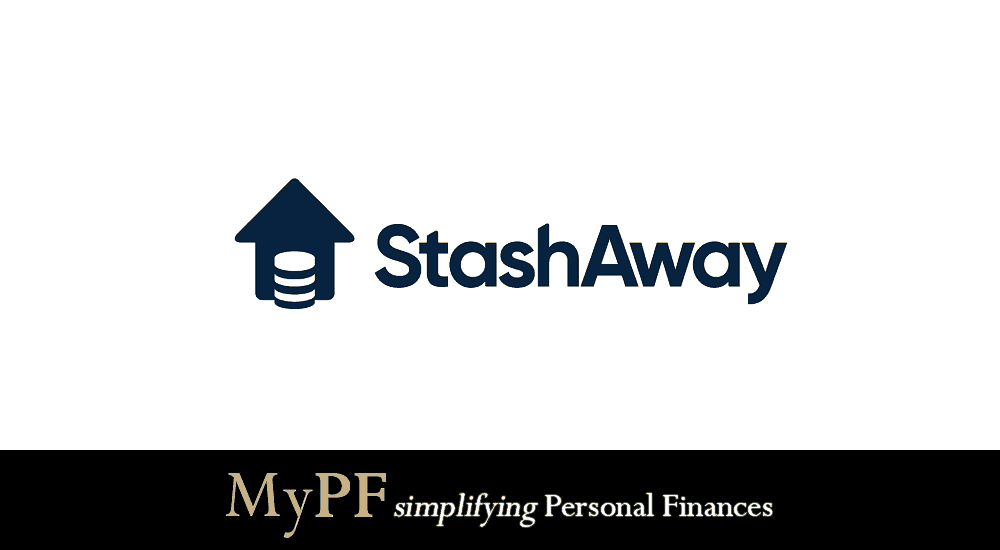
Contents
What is StashAway?
StashAway is a data-driven digital wealth management platform that personalizes financial planning and portfolio management for the vast range of needs of both retail and accredited investors.
It was founded on the belief that redefining wealth management is more than creating an app and a modern user experience; it’s about making sophisticated investment strategies accessible to both retail and accredited investors, leveraging advanced technology and data, and establishing trust with consumers as their world becomes increasingly mobile, technological, and ultra-personalized.
The digital wealth management investment product was launched in July 2017.
Team
Founded in 2016 by Michele Ferrario, former Group CEO of ZALORA; Freddy Lim, former Managing Director and Global Head of Derivatives at Nomura; and Nino Ulsamer, founder of multiple successful technology companies around the world.
Other team members include Rachel Dance, Group Head of Communications; Wong Wai Ken, Malaysia Country Manager; and Albert Kok, Malaysia Co-Country Manager.
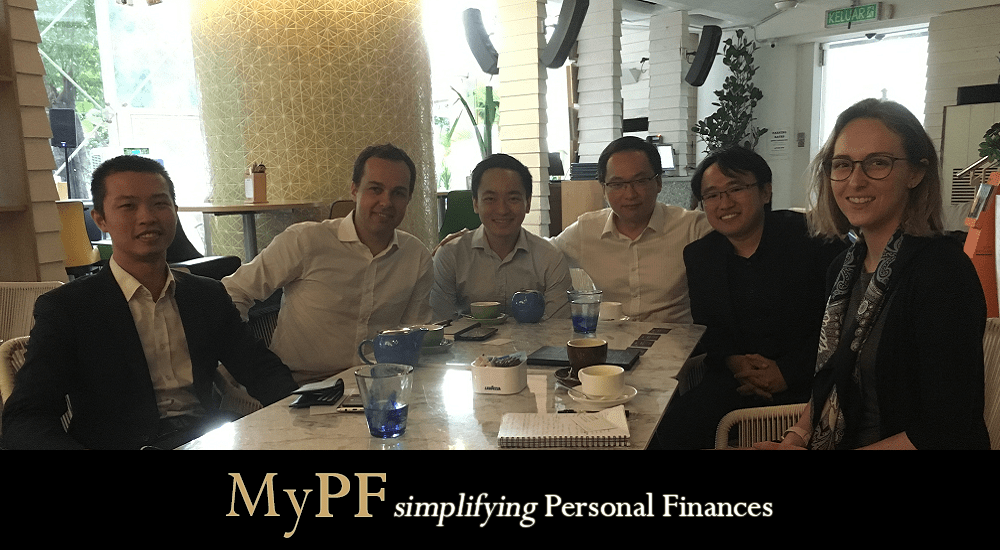
(From L-R: Ken, Michele, Albert, Freddy, Stev from MyPF, Rachel)
Licenses
In Singapore, StashAway operates with a Capital Market Services License for Retail Fund Management from Monetary Authority of Singapore (MAS).
In Malaysia, StashAway operates with a Digital Investment Management License from the Securities Commission Malaysia (SC).
“When you think about how 43% of gross financial assets in Malaysia are in bank deposits, it’s clear that current investment options aren’t doing their jobs of enabling Malaysians to build their long-term wealth through intelligent investing. This huge amount of wealth sitting in cash proves that the financial services industry has failed thus far to equip Malaysians with the right investment tools.” ~Co-founder and Group CEO, Michele Ferrario
Why StashAway
StashAway sets itself apart uniquely:-
- No minimum balance requirement
- No lock-up period
- No sales charge
- Flexible withdrawals and deposits
- Low annual management fees
- First RM50,000: 0.8%
- Any additional amount above RM50,000 up to RM100,000: 0.7%
- Any additional amount above RM100,000 up to RM250,000: 0.6%
- Any additional amount above RM250,000 up to RM500,000: 0.5%
- Any additional amount above RM500,000 up to RM1,000,000: 0.4%
- Any additional amount above RM1,000,000 up to RM3,000,000: 0.3%
- Any additional amount above RM3,000,000: 0.2%
- Accept deposits in Ringgit Malaysia (RM)
- Available 24/7 through iOS and Android App, and desktop
- Responsive, real-person customer support team
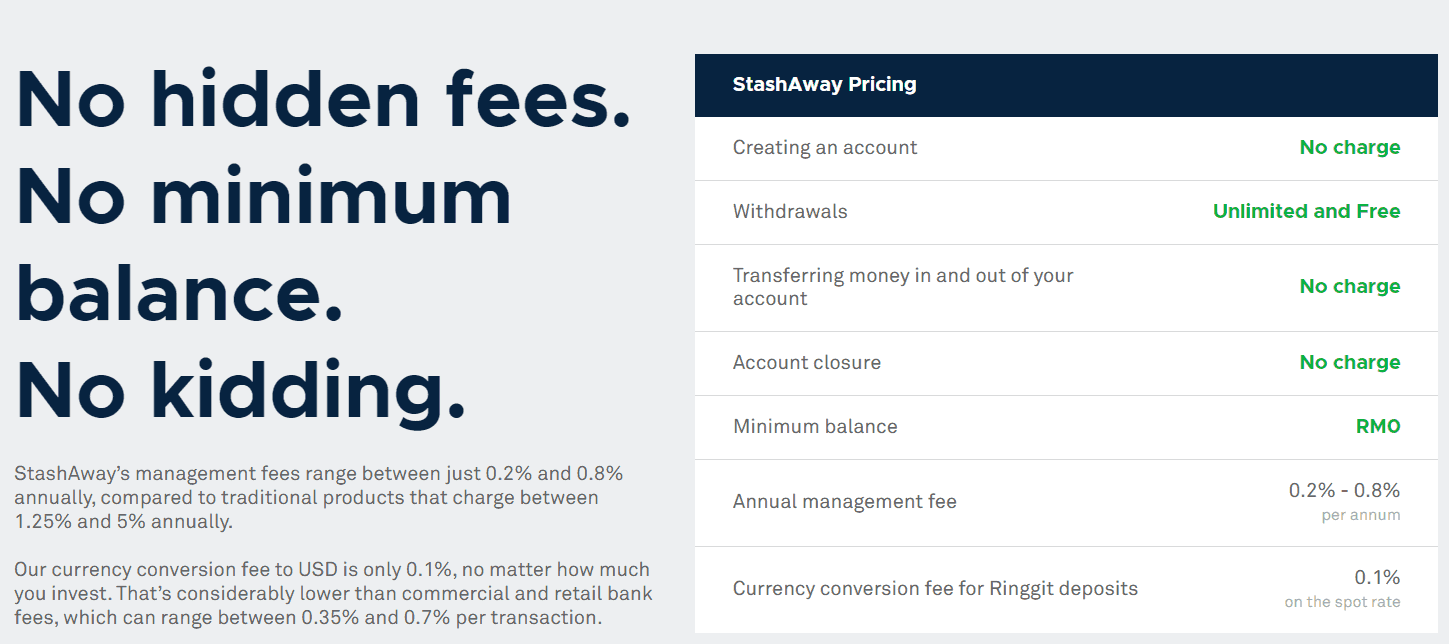
Signup for StashAway
Investment Strategy
StashAway’s investment team designed an investment strategy that focuses on maximizing returns while maintaining a given risk level under any economic condition. StashAway calls the investment strategy, Economic Regime-based Asset Allocation (ERAA).
ERAA is intrinsically designed to navigate the ups and downs of economic cycles, and it ignores market noise. StashAway’s system manages each portfolio’s asset allocation based on how the asset classes historically perform in similar economic environments. In short, when economic data indicate a change in the economic environment or a valuation gap in an asset, the technology prepares the affected portfolio by re-adjusting the asset allocation to maintain the determined risk levels set by each individual client.
After in-depth back testing, it is confirmed that ERAA would have outperformed in risk-adjusted terms during the global financial crisis of 2008, as well as over even longer time horizons.
Technology
StashAway’s technology is what supports the investment framework. It builds dynamic, personalized portfolios for each client by considering personal factors, such as salary, age, risk tolerance, and time horizon to reach a goal, and then combines those with external factors, such as the market and economic conditions.
The technology manages the portfolio to ensure that the personal settings are always accounted for in the face of changing economic and market conditions that it looks out for.
All security trading happens automatically and aggregately, which maximizes efficiency that StashAway passed along to customers in the form of lower fees.
“We’ve seen what’s been happening in the investment space in countries around the world, and by now, we expect these low-cost, convenient, transparent, and sophisticated investment options to be available to us. Over-priced, inconvenient and one-size-fits-all Unit Trusts and Investment Linked Policies don’t cut it anymore. Malaysia’s population is growing and life expectancy is increasing; we need investment solutions that enable us to manage our growing wealth better.” ~Wong Wai Ken, Malaysia Country Manager
Examining ERAA
Traditionally, portfolios have been optimized according to the Nobel Prize-winning Modern Portfolio Theory (MPT). However, academic and industry research indicate that MPT fails to consider the impact of external, changing economic conditions, and how they impact returns.
ERAA (Economic Regime-based Asset Allocation) enhances MPT by addressing external economic forces, which ultimately drive asset class’ returns, volatility, and correlations.
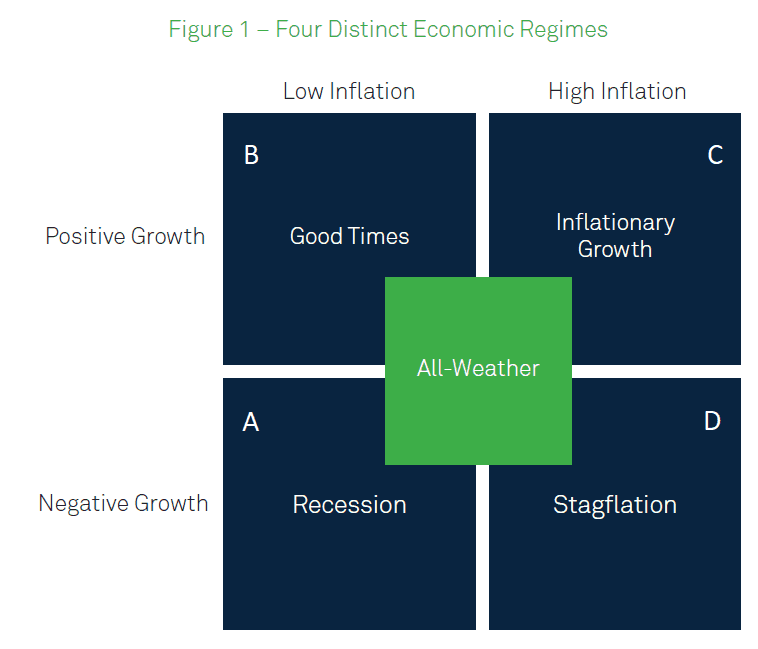
Economic Regime-based Asset Allocation
Long-term studies have concluded that asset allocation is responsible for between 80% to 96% of a portfolio’s return profile. StashAway delivers institutional-level asset allocation sophistication to everybody through a proprietary investment strategy, ERAA, that leverages macroeconomic data to minimize risk and maximize returns for every portfolio throughout economic cycles.
ERAA’s systematic approach avoids human biases, and enables the use of thousands of historical data points in each portfolio construction decision. The three fundamental guiding tenets of ERAA are:
Pillar I: Economic Regimes Determine Asset Allocation
ERAA looks at the relative rate of change between growth and inflation to define an economic regime, then makes informed asset allocation decisions. StashAway has identified four distinct economic regimes, and built the appropriate asset allocations for each of them. The system will proactively determine a new asset allocation target for any given portfolio when the economic regime changes.
In the face of unclear economic data, ERAA evaluates the momentum of growth and/or inflation for clear guidance on direction. If the momentum is not solid enough to provide predictive guidance, ERAA will adjust clients’ portfolios to an All-Weather strategy that optimizes portfolios to withstand uncertain economic conditions.

Pillar II: Risk Shield
ERAA responds to abnormal market behavior when market prices’ moving averages lead to two or more death crosses. In this situation, ERAA overrules the economic-driven parts of the model (Pillar I), and moves customers’ portfolios to a protective asset allocation strategy until the markets regain clarity.
Pillar III: Valuation Gaps
ERAA uses medium-term valuation gaps and their mean-reversion to embed a forward-looking view on asset class performance.

When any of the three pillars trigger a change in the optimal asset allocation for any risk point, a “re-optimization” of the portfolios is triggered, with the dual goal of
- Maintaining risk constant across varying economic and/or market conditions
- Optimizing returns in the new environment.
Re-optimization: Keeping risk constant and optimizing returns for varying economic and market conditions
ERAA’s three pillars, Economic Regimes Determine Asset Allocation, Risk Shield, and Valuation Gaps, together deliver a macroeconomic portfolio management strategy that minimizes risk and maximizes returns for personalized portfolios across any economic environment.
ERAA and the 2008 Financial Crisis
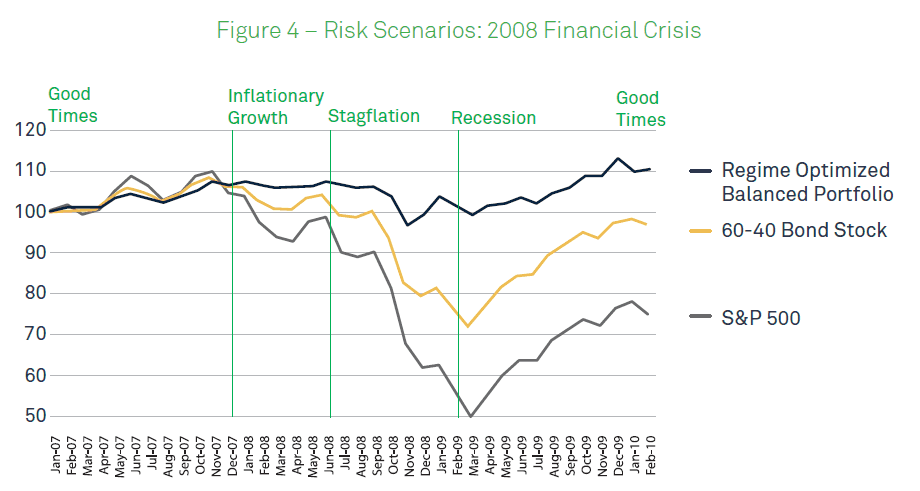
The US economy was moving from Regime B (good times) to Regime C (inflationary growth) as early as late 2007. This period was characterized by positive growth with an inflation rate that was higher than 3.1%. Six months later, the economy shifted from Regime C (inflationary growth) to Regime D (stagflation).
Stagflation: a period of economic stagnation, high unemployment, and high inflation
The first warning sign on growth came in May 2008 when US industrial production registered its first negative print of -1.0% YoY. It turned out that growth momentum had turned negative while headline inflation was around 4.1% and rising.
By the time Lehman Brothers failed in September 2008, US industrial production had deteriorated from -1% to a low of -8.3% YoY and the economy had been showing negative growth for 5 months.
Post-Lehman bankruptcy, headline inflation managed to stay around 5% for some time. It was not until December 2008 that the first negative inflation momentum was observed. Thereafter, inflation started to dip rapidly. By February 2009, the US economy had shifted from stagflation to a regime that was simultaneously in a recession and low inflation (Regime A).
In brief, ERAA would have spotted the first signs of trouble and started reducing portfolio risks as early as May 2008 when the economy went into stagflation. By December 2008, when negative inflation momentum was observed, the investment algorithm would have made another shift, from a stagflationary portfolio to a recessionary portfolio.
The benefits of this approach can be observed in Figure 4. Throughout the crisis, an ERAA-balanced portfolio would have significantly outperformed both the S&P 500 as well as the 60-40 stock-bond benchmark. It also would have had significantly fewer drawdowns, leading to better performance after the 2008 Financial Crisis.
Conclusion
Studies have shown that the majority of returns come from asset allocation. History has also shown us that it’s the economy, not the markets, that ultimately drives returns over the medium to long term. Traditionally, asset allocation strategies target risk, but do not inherently manage risk proactively. StashAway integrates a comprehensive and proprietary risk management strategy with asset allocation strategy, giving rise to ERAA, which maximizes returns and minimizes risk for retail and accredited investors alike.
StashAway x MyPF exclusive signup privileges!
- StashAway Malaysia promo code 0% fees for RM100k invested for 6 months: signup link
- StashAway Singapore promo code 50% fees for SGD50k invested for 6 months: signup link





Leave A Comment